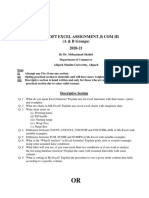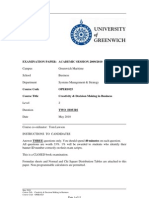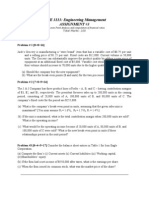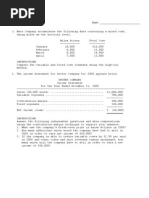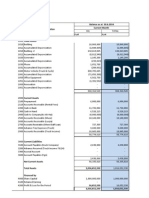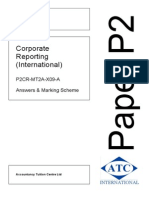Lcci BS 1
Lcci BS 1
Uploaded by
Kyaw Htin WinCopyright:
Available Formats
Lcci BS 1
Lcci BS 1
Uploaded by
Kyaw Htin WinOriginal Description:
Original Title
Copyright
Available Formats
Share this document
Did you find this document useful?
Is this content inappropriate?
Copyright:
Available Formats
Lcci BS 1
Lcci BS 1
Uploaded by
Kyaw Htin WinCopyright:
Available Formats
1
Presentation of data
EHERCISE 2A
The ages of the employees of a company are shown in the following table:
Age (years) Number of employees
15 and under 25 21
25 and under 35 37
35 and under 45 25
45 and under 55 12
55 and under 65 5
Draw a histogram for the above data.
EXERCISE 2B
A company decided to research the price of personal computers on the market. An analysis of
advertisements in the press and specialised computer magezines produced the following information:
Price () Number of personal computers
205 and under 500 5
500 and under 1,000 12
1,000 and under 1,500 15
1,500 and under 2,000 9
2,000 and under 3,000 6
3,000 and under 5,000 3
Draw a histogram of the data.
EXERCISE 2C
The staffs of a company are employed in either production, sales or administration. There are 180
production staff, 75 sales staff and 45 administrative staff.
Construct 2 different, suitable, well-label led diagrams to illustrate these figures.
EXERCISE 2D
Advertising expenditure and sales revenue of XYZ company
Year Advertising expenditure( millions) Sales revenue ( millions)
1 4 86
2 5 93
3 5.5 95
4 6 102
5 7 112
6 8 132
7 10 146
8 12 168
2
9 15 182
10 17 202
EXERCISE 2E
Wealth distribution in the United Kingdom in 1988
Most wealthy (%) Marketable wealth
(%)
Marketable wealth plus occupational and State pension
rights (%)
1 17 10
5 38 24
10 53 36
25 75 60
50 94 83
All 100 100
Note:
The data is given cumulatively, ie the most wealthy 5% includes the most wealthy 1%.
On the same graph draw Lorenz curves for:
Marketable wealth
Marketable wealth plus occupational and State pension rights
Briefly comment about the distribution of wealth in the UK
EHERCISE 2F
The following table shows the value(in thousand) of the sales of a company for 1985 and 1986.
1985 1986
January 29.5 32.2
February 30.6 36.9
March 38.4 42.1
April 42.8 50.5
May 39.3 41.3
June 47.9 45.4
July 48.4 51.7
August 47.6 53.9
September 44.2 48.3
October 39.1 45.2
November 38.4 33.9
December 34.3 38.6
Construct a Z chart to represent the data.
3
Exercise 2F
1986 1986 Moving
data Cumulative data Annul total
January 32.2 32.2 483.2
February 36.9 69.1 489.5
March 42.1 111.2 493.2
April 50.5 161.7 500.9
May 41.3 203.0 502.9
June 45.4 248.4 500.4
July 51.7 300.1 503.7
August 53.9 354.0 510.0
September 48.3 402.3 514.1
October 45.2 447.5 520.2
November 33.9 481.4 515.7
December 38.6 520.0 520.0
Monthly sales commission () of 100 representatives
Range of commission () Number of representatives
under 30 2
30 and under 35 4
35 and under 40 9
40 and under 45 15
45 and under 50 19
50 and under 55 22
55 and under 60 13
60 and under 65 8
65 and under 70 5
70 and over 3
Total 100
4
EXERCISE 3A
The ages of the employees of a company are shown in the following table:
Age (years) Number of employees
15 and under 25 21
25 and under 35 37
35 and under 45 25
45 and under 55 12
55 and under 65 5
Find the mode by both the graphical method and the calculation method. (This data was used in
Exercise 2A.)
(Answer: calculation method = 30.7 years )
EXERCISE 3B
The hourly earnings () of a random sample of 11 employees of a company were found to be as shown
below:
6,9,6,12,8,9,6,7,10,4,11
From the above date find the following measures of location:
median
mode
arithmetic mean
geometric mean.
(Answer: 8, 6, 8, 7.64)
EXERCISE 3C
Using the data of exercise 3B find the:
range
interquartile range
quartile deviation
mean deviation
standard deviation.
(Answers: 8,4,2,2,2,34)EXERCISE 3D
The 1987 profit (or loss) levels of 100 companies in the food industry are shown in the following table:
Profit ( millions) Number of companies
5
Under-4 0
-4 and under 0 7
0 and under 4 21
4 and under 8 35
8 and under 12 24
12 and under 16 9
16 and under 20 4
20 and over 0
(a) Construct a cumulative frequency curve for these figures.
(b) Using your graph, or otherwise, find the values of the median and quartile deviation.
(c) State what the median and quartile deviation measure.
Second Level
(Answers: (b) calculation method 6,514,000;3,286,000)
EXERCISE 3E
Profit of companies
Profit
( million)
Number of companies
under 2 30
2 and under 4 20
4 and under 6 10
6 and under 10 8
10 and under 15 5
(a) Calculate the mean.
Note:
The answer assumes that the lower boundary for the first group is zero.
(Answer: 3,650,000)
EXERCISE 3F
This uses the data of Exercise 3E.
Calculate the standard deviation.
(Answer: 3,270,000)
6
Skewness and coefficient of variation
EXERCISE 4A
This exercise is based on the data of Exercise 3E.
Profit of companies
Profit ( million) Number of companies
Under 2 30
2 and under 4 20
4 and under 6 10
6 and under 10 8
10 and under 15 5
Calculate the mean and the standard deviation. You could use the results of Exercises 3E and
3F,then calculate the coefficient of variation.
(Answers: 3,650,000,3,270,000,89.6%
EXERCISE 4B
This exercise is based on the data of Exercise 3E.
Profit of companies
Profit (million) Number of companies
under 2 30
2 and under 4 20
4 and under 6 10
6 and under 10 8
10 and under 15 5
(a) Draw a histogram to represent this information.
(b) Calculate the mean, median and the standard deviation.
(c) Calculate a measure of skewness.
(d) Comment on your histogram and the results of parts(b) and (c).
(Answers: (b)3,650,000,2,650,000, 3,270,000; (c) 0.917)
7
EXERCISE 4C
This uses the data of Exercise 3D.
The 1987 profit (or loss)levels of 100 companies in the food industry are shown in the following
table:
Profit ( millions) Number of companies
under-4 0
-4 and under 0 7
0 and under 4 21
4 and under 8 35
8 and under 12 24
12 and under 16 9
16 and under 20 4
20 and over 0
(a) Find the values of the median and the quartiles.
(b) Calculate the quartile measure of skewness.
(Answer: (a) results based on calculation method 6,514,000, 3,429,000,10,000,000;
(b) 0.061)
8
Correlation and regression
EXERCISE 5A
A company has a number of branch offices which vary in size and have varying numbers of
employees. The following data shows the number of employees at each branch office and the
annual cost of running the branch office.
Branch office Number of employees Annual cost (1,000
A 11 64
B 6 70
C 16 78
D 9 62
E 25 128
F 14 74
G 8 60
H 19 90
(a) Plot the data on a scatter diagram and comment briefly on your diagram.
Part question Second Level
EXERCISE 5B
This exercise uses the data of Exercise 5A and is a continuation of the question.
A company has a number of branch offices which vary in size and have varying numbers of
employees. The following data show the number of employees at each branch office and the
annual cost of running the branch office.
Branch office Number of employees Annual cost (1,000)
A 11 64
B 6 70
C 16 78
D 9 62
E 25 128
F 14 74
G 8 60
H 19 90
(b) Calculate the least squares regression line, which would enable you to forecast annual cost
for a given number of employees.
(c) Use your regression line to forecast the annual cost of a new office which is about to open
and will have 30 employees. Discuss the likely accuracy of your forecast.
9
EXERCISE 5C
The following data refers to the floor space and the turnover of 10 small companies:
Company Turnover($1,000) Floor space (square metres)
A 85 52
B 150 76
C 128 62
D 160 70
E 70 45
F 290 78
G 180 60
H 118 54
I 175 68
J 136 84
(a) Draw a suitable scatter diagram of the data.
(b)Calculate the product moment correlation coefficient.
EXERCISE 5D
Calculate the coefficient of determination for the data of Exercise 5C.
EXERCISE 5E
(a) Ten applicants for a post were given an aptitude test and an interview. E was placed first on
the aptitude test followed by A,G,J,C,L,B,D,F and H in that order. In the interviews, G was placed
first, followed by E,J,A,B,C,I,H,D and F in that order.
Calculate the value of Spearmans rank correlation coefficient and, without performing a
significance test, interpret the value obtained.
(b) State 2 situations in which Spearmans rank correlation coefficient should be calculated
rather than the product moment correlation coefficient.
EXERCISE 5F
An investigation was conducted by a company on the value of educational and aptitude tests as
assessment methods for recruiting employees. It is the present practice of the company to give recruits
such tests when they apply for posts.
The following data gives the educational and aptitude test scores, together with an assessment score by
the personnel department of their ability one year after joining the company. One is a low score and 20
a high score.
10
Employee Educational test Aptitude test Assessment by
personnel officer
A 9 17 12
B 10 14 14
C 15 12 16
D 14 13 15
E 16 10 17
F 11 15 10
G 12 12 11
H 17 16 18
(a) Rank each set of data.
(b) Calculate 2 appropriate rank correlation coefficients.
(c) Write a brief report on your findings.
EXERCISE 5G
(c) Test whether the correlation coefficient found in Exercise 5C(0.8403) differs significantly from zero,
and:
(d) Comment on your results.
11
Index number
EXERCISE 6A
(a) Give the relative advantages and disadvantages of Laspeyres and Paasche price index
numbers.
(b) The following data shows the quantities and prices of 4 components purchased by a
company in Year 1 and Year 6.
Year 1 Year 6
Component Price() Quantity Price() Quantity
1 5.00 200 8.50 180
2 10.00 150 13.50 120
3 8.00 100 10.00 95
4 12.50 80 15.50 70
(i) Calculate a Laspeyres price index which shows the change in prices between Years 1 and 6.
(ii) Calculate a Paasche quantity index which shows the change in quantities between years 1
and 6.
Briefly comment on your results in parts (i) and (ii).
EXERCISE 6B
(a) Give the relative advantages and disadvantages of Laspeyres and Paasche price index
numbers.
(b) The following data shows the revenue and prices of 4 products (A to D) sold by a company in
Year 1 and Year 4.
Year 1 Year 4
Product Price() Revenue() Price() Revenue()
A 5.00 400 8.00 640
B 8.00 560 14.00 700
C 9.00 450 12.00 360
D 12.00 288 15.00 300
(i) Calculate a Laspeyres price index which shows the change in prices between Years 1 and 4.
(ii) Calculate a Paasche quantity index which shows the change in quantities between Years 1
and 4.
12
(iii) Briefly comment on your results in parts (i) and (ii).
EXERCISE 6C
The following data shows the 5 main groups which make up the components of the index of
retail prices, together with the weights and price relatives:
Group Weights Price relative Jul 1993 (Jan
1987 = 100)
Food and catering 189 136.8
Alcohol and tobacco 113 156.0
Housing and household
expenditure
336
140.5
Personal expenditure 97 127.0
Travel and leisure 265 142.9
Source: Monthly Digest of Statistics
(a) Calculate the index of retail prices for July 1993 with January 1987=100.
(b) Outline the uses of the index of retail prices to a business person.
Part question Third Level
EXERCISE 6D
Use the index obtained in the solution to Exercise 6C (140.9).
The index of retail price for January 1987 with January 974=100 was 394.5.
Calculate the index of retail prices for July 1993 with January 1974=100.
EXERCISE 6E
Use the result of Exercise 6D (555.9).
In July 1979 a person retired with a pension of 5,000 per annum. The pension was index
linked, ie increased at the same rate of increase as the index of retail prices. In July 1979 the
index of retail prices was 229. 1 with January 1974 =100. Calculate the pension of this person in
July 1993.
EXERCISE 6F
The average salary in a company and the index of retail prices is given below.
13
Year Average salary Index of retail prices
() (Jan 1987=100)
1988 18,000 106.9
1989 20,000 115.2
1990 23,00 126.7
(a)Convert the index of retail prices to a series with 1988=100.
(b) Calculate the real salary for each year relative to 1988 prices and comment on your result.
14
Time series
EXERCISES 7A
(a) Briefly describe the components which make up a time series.
(b) The following data shows the volume of gas (100 millions of thermal units) produced in the
United Kingdom from 1990 to 1992.
Gas production 1990-1992
Year Jan-Mar Apr-Jun Jul-Sep Oct-Dec
1990 66 37 26 62
1991 74 43 24 64
1992 70 37 27 70
Source: Monthly Digest of Statistics
(i) Plot the data on a graph.
EXERCISE 7B
This exercise is a continuation of Exercise 7A.
(a) (ii) Using the data of Exercise 7A, find, by means of a moving average, the trend .
(iii) Plot the trend on the graph found in Exercise 7A.
EXERCISE 7C
This worked example is a continuation of Exercise 7A.
(b) (iv) Using the data of Exercise 7A and your results of Exercise 7B, obtain the seasonal factors
using the additive model.
EXERCISE 7D
This exercise is a continuation of Exercise 7A.
(b) (v) Using the data of Exercise 7A and your results of Exercise 7C, obtain the seasonally
adjusted figures for the 4 quarters of 1992 using the additive model.
EXERCISE 7E
This exercise is a continuation of Exercise 7A.
15
(b) (vi) Using the data of Exercise 7A and your results of Exercise 7C, obtain a forecast for the 4
quartersof 1993 using the additive model. Discuss the likely accuracy of your forecasts.
EXERCISE 7F
(a) Briefly describe the components of a typical time series.
(b) A large shop opens six days a week, Monday to Saturday. The sales for three weeks, in $100,
were recorded as shown below:
Mon Tue Wed Thu Fri Sat
Week 1 142 154 98 128 182 285
Week 2 151 166 102 141 192 302
Week 3 159 172 106 146 199 320
(i) Using a moving average, find the trend and the average daily adjustments.
(ii) Forecast sales for the first two days of Week 4, and briefly discuss the likely accuracy of your
forecast.
EXERCISE 7G
(a) Explain why it is necessary to adjust seasonally time series data.
(b) The following data shows the output of a factory over a 3-week period. The factory works a
5-day week.
Mon Tue Wed Thu Fri
Week 1 86 92 104 98 78
Week 2 90 99 110 102 80
Week 3 93 101 116 110 83
(i) By means of a moving average, find the trend and the average daily variations.
(ii) Seasonally adjust the data for Week 3. What does this show ?
16
Probability
EXERCISE 8A
A company submits tenders for 4 contracts. The probabilities of acceptance are 0.4, 0.6, 0.5 and
0.2 respectively. Assuming that these are independent events, calculate the probability that the
company will:
(i) obtain all 4 contracts, (ii) obtain no contracts, (iii) obtain exactly one contract.
EXERCISE 8B
This is an extra part of Exercise 8A.
(iv) Find the probability that the company will obtain at least one contract.
EXERCISE 8C
A motor insurance company classifies its customers into 4 claims categories: very good (10%), good (30%), average (20%) and
poor (40%). The figures in brackets show the percentage of their customers in each classification. The claims record shows that
the percentage in each classification making at least one claim over the previous year is as follows:
Claims category Percentage making at least one claim
Very good 5%
Good 10%
Average 30%
Poor 60%
Assuming that there is no change in these percentages, find the probability that if a customer is
selected at random:
(i) the customer will make at least one claim next year.
EXERCISE 8D
This is a continuation of Exercise 8C.
Find the probability that if a customer makes at least one claim, the person will come from the
very good classification.
EXERCISE 8E
17
A company planned to recruit 30 administrative staff. The company recruits from 3 categories;
graduates, professionally qualified and those with administrative experience. The company
received 200 applications, some not in any of the categories listed above.
An analysis of the applicants showed that 120 were graduates, 40 had professional
qualifications and 60 had administrative experience. Of the graduates 20 were professionally
qualified, 22 had administrative experience and 5 had professional qualifications and
administrative qualifications (these 5 were counted in the earlier categories). Of those with
administrative experience 18 had professions (these included the 5 mentioned above).
You might also like
- Excel Advanced AssignmentDocument20 pagesExcel Advanced AssignmentPoh WanyuanNo ratings yet
- Business School ADA University ECON 6100 Economics For Managers Instructor: Dr. Jeyhun Mammadov Student: Exam Duration: 18:45-21:30Document5 pagesBusiness School ADA University ECON 6100 Economics For Managers Instructor: Dr. Jeyhun Mammadov Student: Exam Duration: 18:45-21:30Ramil AliyevNo ratings yet
- Sample ExamDocument9 pagesSample ExamrichardNo ratings yet
- Mean, Median and Mode - Module1Document8 pagesMean, Median and Mode - Module1Ravindra Babu100% (1)
- Data Interpretation Guide For All Competitive and Admission ExamsFrom EverandData Interpretation Guide For All Competitive and Admission ExamsRating: 2.5 out of 5 stars2.5/5 (6)
- 2004Document20 pages2004Mohammad Salim HossainNo ratings yet
- EXERCISE Before FinalDocument15 pagesEXERCISE Before FinalNursakinah Nadhirah Md AsranNo ratings yet
- IT LAB Question BankDocument7 pagesIT LAB Question BankGopi KrishnaNo ratings yet
- Excel Assignment (2) 1 1Document29 pagesExcel Assignment (2) 1 1Sonali ChauhanNo ratings yet
- Introduction To Spreadsheets - FDP 2013Document24 pagesIntroduction To Spreadsheets - FDP 2013thayumanavarkannanNo ratings yet
- Tutorial Questions: Quantitative Methods IDocument5 pagesTutorial Questions: Quantitative Methods IBenneth YankeyNo ratings yet
- Content Hull 8763Document10 pagesContent Hull 8763DWNo ratings yet
- Purpose of This AssignmentDocument16 pagesPurpose of This AssignmentAdznida DaudNo ratings yet
- 11 Questions BBA (Hons) (19 Pages)Document18 pages11 Questions BBA (Hons) (19 Pages)Bangladesh Gonit FoundationNo ratings yet
- Business Statistics L3 Past Paper Series 2 2011Document7 pagesBusiness Statistics L3 Past Paper Series 2 2011Haznetta Howell100% (1)
- Quantitative Methods For Business and Management: The Association of Business Executives Diploma 1.14 QMBMDocument25 pagesQuantitative Methods For Business and Management: The Association of Business Executives Diploma 1.14 QMBMShel LeeNo ratings yet
- ACC 205 Exam Question.(1) 2Document5 pagesACC 205 Exam Question.(1) 2taykemsmartsetNo ratings yet
- Model Question Paper - Industrial Engineering and Management - First Semester - DraftDocument24 pagesModel Question Paper - Industrial Engineering and Management - First Semester - Draftpammy313No ratings yet
- Microsoft Excel Assignment, B Com Iii (A & B Groups) 2020-21Document4 pagesMicrosoft Excel Assignment, B Com Iii (A & B Groups) 2020-21Feel The MusicNo ratings yet
- Past Paper - 201005 MayDocument13 pagesPast Paper - 201005 MayPeggy Chan0% (1)
- Higher Eng Maths 9th Ed 2021 Solutions ChapterDocument17 pagesHigher Eng Maths 9th Ed 2021 Solutions ChapterAubrey JosephNo ratings yet
- Content of Exercises For The Course Statistics in Economics and ManagementDocument2 pagesContent of Exercises For The Course Statistics in Economics and ManagementLonerStrelokNo ratings yet
- CORE NotedDocument3 pagesCORE Notedminehacks95No ratings yet
- Bcom 3 Sem Quantitative Techniques For Business 1 19102079 Oct 2019Document3 pagesBcom 3 Sem Quantitative Techniques For Business 1 19102079 Oct 2019lightpekka2003No ratings yet
- Bmme 5103Document12 pagesBmme 5103liawkimjuan5961No ratings yet
- ACC 205 Exam Question2Document4 pagesACC 205 Exam Question2taykemsmartsetNo ratings yet
- PMC Examination Winter 2011Document5 pagesPMC Examination Winter 2011pinkwine2001No ratings yet
- Practical 1-1 MergedDocument16 pagesPractical 1-1 Mergedpese4095No ratings yet
- Bhaskar Tutorials Business Statistics Part - A (5 Marks)Document4 pagesBhaskar Tutorials Business Statistics Part - A (5 Marks)Bhaskar BhaskiNo ratings yet
- Assignment 3 Sem 1-11-12Document5 pagesAssignment 3 Sem 1-11-12Hana HamidNo ratings yet
- Bank&InsurDocument14 pagesBank&Insurammusamaya1416No ratings yet
- Revised 202101 Tutorial STUDENTS VERSION UBEQ1013 Quantitative Techniques IDocument53 pagesRevised 202101 Tutorial STUDENTS VERSION UBEQ1013 Quantitative Techniques IPavitra RavyNo ratings yet
- MS Spreadsheet Practical assignment (2)Document5 pagesMS Spreadsheet Practical assignment (2)leviwaguraNo ratings yet
- 3 Yrs ADMDocument13 pages3 Yrs ADMKarthik AnanthaNo ratings yet
- 12 01Document9 pages12 01Zahid RaihanNo ratings yet
- Abdullah BDMDocument17 pagesAbdullah BDMMuhammad Ramiz AminNo ratings yet
- c9a09ASSIGNMENT 2Document2 pagesc9a09ASSIGNMENT 2Kriti BoseNo ratings yet
- MBA Exam - SGDocument9 pagesMBA Exam - SGaliaa alaaNo ratings yet
- Assignemnt 2Document4 pagesAssignemnt 2utkarshrajput64No ratings yet
- Mba 1 Sem Quantitative Methods 2017Document1 pageMba 1 Sem Quantitative Methods 2017pt30304No ratings yet
- Econometrics Test 1Document4 pagesEconometrics Test 1ygantsaNo ratings yet
- Practice Problems Upto Forecasting - Dec 2010Document6 pagesPractice Problems Upto Forecasting - Dec 2010Suhas ThekkedathNo ratings yet
- MS Excel-2Document14 pagesMS Excel-2rhythm mehtaNo ratings yet
- Rolando Final ProjectDocument15 pagesRolando Final Projectapi-242856546No ratings yet
- Apptitude HandbookDocument132 pagesApptitude Handbookhamoelsyed2005No ratings yet
- BST Unit Wise QPDocument13 pagesBST Unit Wise QPDivya DCMNo ratings yet
- MGMT Sample ExamDocument9 pagesMGMT Sample ExamKenny RodriguezNo ratings yet
- B Q2 ModuleDocument9 pagesB Q2 ModulepkgkkNo ratings yet
- 516 HW327 SolDocument5 pages516 HW327 SolJimmy PrehnNo ratings yet
- Bus 321 Operations Management: Review Exercices Chapter 2-3Document30 pagesBus 321 Operations Management: Review Exercices Chapter 2-3GjergjiNo ratings yet
- Mean, Median and Mode - Module 1Document8 pagesMean, Median and Mode - Module 1Ravindra Babu0% (1)
- W 15.2.6 T A F SPSS: Orksheet IME Series Nalysis AND Orecasting WithDocument8 pagesW 15.2.6 T A F SPSS: Orksheet IME Series Nalysis AND Orecasting Witharies0703No ratings yet
- MGT 2070 - Sample MidtermDocument8 pagesMGT 2070 - Sample MidtermChanchaipulyNo ratings yet
- 08 QuestionsDocument8 pages08 Questionsw_sampathNo ratings yet
- Numerical Test 5 SolutionsDocument16 pagesNumerical Test 5 Solutionslawrence ojuaNo ratings yet
- Complete Set Tutorial Sheets 1-10Document17 pagesComplete Set Tutorial Sheets 1-10APOORV AGARWALNo ratings yet
- The New Economics for Industry, Government, Education, third editionFrom EverandThe New Economics for Industry, Government, Education, third editionRating: 4 out of 5 stars4/5 (18)
- Statistical Thinking: Improving Business PerformanceFrom EverandStatistical Thinking: Improving Business PerformanceRating: 4 out of 5 stars4/5 (1)
- Economic and Financial Modelling with EViews: A Guide for Students and ProfessionalsFrom EverandEconomic and Financial Modelling with EViews: A Guide for Students and ProfessionalsNo ratings yet
- June'16 Sales QtyDocument61 pagesJune'16 Sales QtyKyaw Htin WinNo ratings yet
- Hercule Monthly AC JUNE 2014Document34 pagesHercule Monthly AC JUNE 2014Kyaw Htin WinNo ratings yet
- Purchase Cash Paid To ESI Date 18.7.2015 RichDocument9 pagesPurchase Cash Paid To ESI Date 18.7.2015 RichKyaw Htin WinNo ratings yet
- Purchase Cash Paid To ESI Date 11.7.15 RichDocument11 pagesPurchase Cash Paid To ESI Date 11.7.15 RichKyaw Htin WinNo ratings yet
- MKN BudgetDocument1 pageMKN BudgetKyaw Htin WinNo ratings yet
- K1 ExpenseDocument30 pagesK1 ExpenseKyaw Htin WinNo ratings yet
- Lcci BS 1Document17 pagesLcci BS 1Kyaw Htin WinNo ratings yet
- Hercule Monthly AC Nov 2012 Dec 2012Document19 pagesHercule Monthly AC Nov 2012 Dec 2012Kyaw Htin WinNo ratings yet
- Hercule Monthly AC APR 2014 11.5.2014Document38 pagesHercule Monthly AC APR 2014 11.5.2014Kyaw Htin WinNo ratings yet
- Hercule Monthly AC-JUNE.2013Document20 pagesHercule Monthly AC-JUNE.2013Kyaw Htin WinNo ratings yet
- Objective: Session 07 - Ias 41 AgricultureDocument10 pagesObjective: Session 07 - Ias 41 AgricultureKyaw Htin WinNo ratings yet
- RTDocument58 pagesRTKyaw Htin WinNo ratings yet
- Hercule Monthly AC-FEB.2013Document19 pagesHercule Monthly AC-FEB.2013Kyaw Htin WinNo ratings yet
- P2CR-Session18 j09Document14 pagesP2CR-Session18 j09Kyaw Htin WinNo ratings yet
- P2CR (Int) SOverview j09Document2 pagesP2CR (Int) SOverview j09Kyaw Htin WinNo ratings yet
- p2 (Int) CR Mt2a Qs j09Document7 pagesp2 (Int) CR Mt2a Qs j09Kyaw Htin WinNo ratings yet
- Corporate Reporting (International) : P2CR-MT2A-X09-A Answers & Marking SchemeDocument11 pagesCorporate Reporting (International) : P2CR-MT2A-X09-A Answers & Marking SchemeKyaw Htin WinNo ratings yet


















